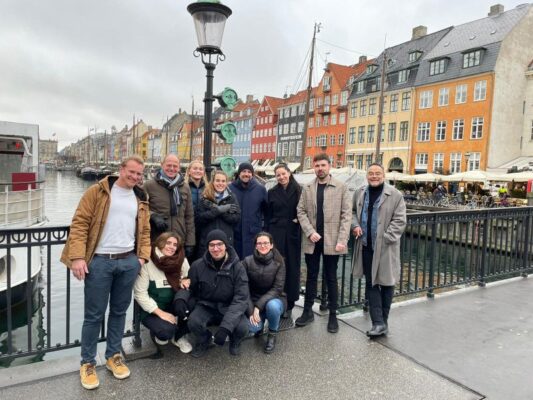This past month, partners from the BEAMER project gathered in the coastal city of Copenhagen, Denmark, to align on critical developments of the BEAMER model—the digital health solution to help improve treatment adherence.
We speak with attending consortium members Frans Folkvord (Behavioural Scientist – PredictBy) and Beatriz Merino (Biomedical Engineer – Polytechnical University of Madrid) to discuss meeting highlights and the progress made to date.
Read more below.
My name is Dr. Frans Folkvord. I work as the director and co-founder of PredictBy and as an associate professor at The Tilburg School of Humanities and Digital Sciences at Tilburg University, which means I represented both consortium partners at this meeting.
My name is Beatriz Merino, and I currently working in the Life Supporting Technologies Research Group at the Polytechnical University of Madrid. I am a Ph.D. biomedical engineer and a project manager of several other European projects addressing health and chronic diseases.
Although the consortium members have met many times online to discuss progress and solutions for upcoming challenges in the first phase of the BEAMER project, the in-person interaction between one another is significantly different.
We have found that the discussions are of much higher quality and ongoing. We spend a lot of time working together on the pending issues, whether in the planned sessions or during lunch and dinner. For instance, in this particular meeting, our conversations led us to start building the data lab and the initial version (v1) of the BEAMER model framework—which are promising and relevant in terms of expected outcomes and the future of the project.

BEAMER Consortium Members in Copenhagen, Denmark (January 2023)
During the two full days, we focused on two core areas:
Because of these efforts, we were able to begin incorporating more insights into the functional development of the model aimed to help support treatment adherence. At the same time, we could look at the potential key elements that require our attention in the short and mid-term to reach the production version of the model.
We’re committed to continuing our work together intensively and constructively, on and offline. As a consortium, we want to establish the subsequent models of the data and BEAMER framework to improve our understanding of patient adherence to treatment.
As everyone is more aware of the challenge and complexity of the issue at hand, we know the next steps we will take to succeed.
For more information about the BEAMER Project and how you can get involved to support its aim to help improve adherence to treatments, visit our page here!
Feel free to share your thoughts by contacting us




Supported by a grant from IMI, the project has received funding from the Innovative Medicines Initiative 2 Joint Undertaking under grant agreement No 101034369. This joint undertaking receives support from the European Union’s Horizon 2020 research and innovation programme, the European Federation of Pharmaceutical Industries and Associations [EFPIA] and Link2Trials. The total budget is 11.9 M€ for a project duration of 60 months.
Disclaimer:
Information on this website reflects project owner’s views and neither IMI nor the European Union, EFPIA, or any Associated Partners are responsible for any use that may be made of the information contained therein.
The primary aim of the end user personas is to support the creation of materials to support the implementation of the BEAMER model framework and to help define requirements for the elements of the BEAMER model framework. Hence, healthcare professionals (HCPs) represent the primary envisaged end user group of the BEAMER model framework and the associated Adherence Intelligence Visualisation Platform (AIVP)
It is one learning from the joint design process that the job titles of healthcare professional team members do not necessarily predict the roles they would play within the change management process for implementing BEAMER and installing it as a standard model within healthcare. Additionally, the role and responsibilities of certain job titles, for example nurse, varies across different healthcare systems and would affect how they interact with the BEAMER model outputs and the access they would be permitted and so it would not be helpful to include these job titles: The four personas represent role-independent archetypes within the group of HCPs. They encompass a Managerial HCP Persona, an Implementer HCP Persona, a Support HCP Persona, and a Established HCP Persona.
These healthcare professional personas may be further tailored to specific healthcare settings depending on the needs of the individual pilot sites. Thus, adapted or spin-off versions of these original personas may be considered. The persona displays include a summarising statement, goals, challenges, experience, and needs to enhance the accessibility and usability of the model while minimising user burden.
Patient organisations are considered potential users of the model outputs. Consequently, personas were designed for these groups to assure that the implementation materials may also support their needs in the longer term, thus fostering sustainability of the project outputs.
The identified focus areas within this persona are goals, needs, skills and tools, along with potential challenges anticipated during the implementation process. The persona emphasises awareness-raising, capacity building, education, peer support provision, and the promotion of research and development in therapeutic care.
The patient organisation persona serves as a theoretical framework representing how patient organisations could benefit from and include the BEAMER model framework in their therapy and care related as well as their organisational work. This persona comprises the needs, goals, challenges and necessary tools, facilitating preparation and implementation of the model and optimising the user experience of patient organisations as end users of the BEAMER model framework. It can be used as a guide to identify potential obstacles and understand the prerequisites for a patient organisation to successfully adopt and integrate the BEAMER model framework.
“In implementing the BEAMER model, we want to be able to respond to the different needs of our patients to ensure their adherence, build a supportive community and improve outcomes.”